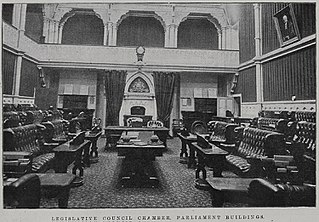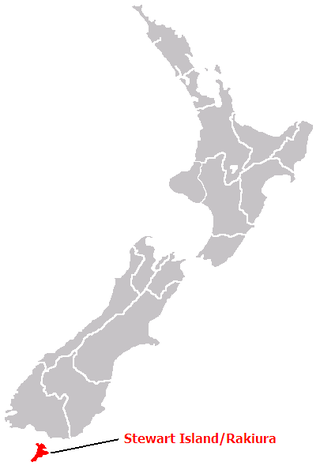
Captain William Hobson was an Anglo-Irish officer in the British Royal Navy, who served as the first Governor of New Zealand. He was a co-author of the Treaty of Waitangi.

The provinces of the Colony of New Zealand existed as a form of sub-national government. Initially established in 1846 when New Zealand was a Crown colony without responsible government, two provinces were first created. Each province had its own legislative council and governor. With the passing of the New Zealand Constitution Act 1852 the provinces were recreated around the six planned settlements or "colonies". By 1873 the number of provinces had increased to nine, but they had become less isolated from each other and demands for centralised government arose. In 1875 the New Zealand Parliament decided to abolish the provincial governments, and they came to an end in November 1876. They were superseded by counties, which were later replaced by territorial authorities.

The New Zealand Parliament is the unicameral legislature of New Zealand, consisting of the Sovereign (King-in-Parliament) and the New Zealand House of Representatives. The King is usually represented by his governor-general. Before 1951, there was an upper chamber, the New Zealand Legislative Council. The New Zealand Parliament was established in 1854 and is one of the oldest continuously functioning legislatures in the world. It has met in Wellington, the capital of New Zealand, since 1865 and in its current building since 1922.

The New Zealand Legislative Council was the upper house of the General Assembly of New Zealand between 1853 and 1951. An earlier arrangement of legislative councils for the colony and provinces existed from 1841 when New Zealand became a colony; it was reconstituted as the upper house of a bicameral legislature when New Zealand became self-governing in 1852, which came into effect in the following year.

New Munster was an early original European name for the South Island of New Zealand, given by the Governor of New Zealand, Captain William Hobson, in honour of Munster, the Irish province in which he was born.

Sir George Gipps was the Governor of the British Colony of New South Wales for eight years, between 1838 and 1846. His governorship oversaw a tumultuous period where the rights to land were bitterly contested in a three way struggle between the colonial government, Aboriginal people and wealthy graziers known as squatters. The management of other major issues such as the end of convict transportation, large immigration programs and the introduction of majority elected representation also featured strongly during his tenure. Gipps is regarded as having brought a high moral and intellectual standard to the position of governor, but was ultimately defeated in his aims by the increasing power and avarice of the squatters.

The constitution of New Zealand is the sum of laws and principles that determine the political governance of New Zealand. Unlike many other nations, New Zealand has no single constitutional document. It is an uncodified constitution, sometimes referred to as an "unwritten constitution", although the New Zealand constitution is in fact an amalgamation of written and unwritten sources. The Constitution Act 1986 has a central role, alongside a collection of other statutes, orders in Council, letters patent, decisions of the courts, principles of the Treaty of Waitangi, and unwritten traditions and conventions. There is no technical difference between ordinary statutes and law considered "constitutional law"; no law is accorded higher status. In most cases the New Zealand Parliament can perform "constitutional reform" simply by passing acts of Parliament, and thus has the power to change or abolish elements of the constitution. There are some exceptions to this though – the Electoral Act 1993 requires certain provisions can only be amended following a referendum.

The governor-general of New Zealand is the representative of the monarch of New Zealand, currently King Charles III. As the King is concurrently the monarch of 14 other Commonwealth realms and lives in the United Kingdom, he, on the advice of his New Zealand prime minister, appoints a governor-general to carry out his constitutional and ceremonial duties within the Realm of New Zealand.

Major General Robert Henry Wynyard was a British Army officer and New Zealand colonial administrator, serving at various times as Lieutenant Governor of New Ulster Province, Administrator of the Government, and was the first Superintendent of Auckland Province.

The New Zealand Constitution Act 1852 was an Act of the Parliament of the United Kingdom that granted self-government to the Colony of New Zealand. It was the second such Act, the previous 1846 Act not having been fully implemented. The purpose of the Act was to have constitutional independence from Britain. The definition of franchise or the ability to vote excluded all women, most Māori, all non-British people and those with convictions for serious offences.

New Leinster was a name given to the Stewart Island in the Royal Charter of November 1840, which stated the division of New Zealand into three parts. The division only held a geographic significance. In the 1846 New Zealand Constitution Act, the area known as New Leinster was incorporated into then established New Munster Province. It was named after Leinster, one of the provinces of Ireland.

The New Zealand Government is the central government through which political authority is exercised in New Zealand. As in most other parliamentary democracies, the term "Government" refers chiefly to the executive branch, and more specifically to the collective ministry directing the executive. Based on the principle of responsible government, it operates within the framework that "the [King] reigns, but the government rules, so long as it has the support of the House of Representatives". The Cabinet Manual describes the main laws, rules and conventions affecting the conduct and operation of the Government.

William Swainson became the second, and last, Attorney-General of the Crown colony of New Zealand and instrumental in setting up the legal system of New Zealand. He was the first Speaker of the New Zealand Legislative Council.
The following lists events that happened during 1853 in New Zealand.
The following lists events that happened during 1852 in New Zealand.

South Island nationalism refers to a nationalist movement in the South Island of New Zealand.

The Colony of New Zealand was a colony of the United Kingdom from 1841 to 1907. British authority was vested in a governor. The colony had three successive capitals: Okiato in 1841; Auckland from 1841 to 1865; and Wellington from 1865. Following the New Zealand Constitution Act 1852, the colony became a Crown colony with its first elected parliament in 1853. Responsible self-government was established in 1856 with the governor being required to act on the advice of his ministers. In 1907, the colony became the Dominion of New Zealand within the British Empire.

The Governor's Council, also known as the Privy Council and Council of State, was the upper house of the legislature of the Colony of Virginia. It also served as an advisory body to the royal governor and as the highest judicial body in the colony. Beginning in the 1630s, its 12 members were appointed by the British sovereign. After Virginia declared its independence from Great Britain in 1776, members were appointed by the General Assembly, and most of their powers were redistributed to the newly formed Senate of Virginia and the state's judiciary. The Council was formally abolished after delegates to the 1850 Virginia constitutional convention voted to enact what became known as the "Reform Constitution," which vested many of its remaining functions in the popularly elected offices of Governor, Lieutenant Governor, and Attorney General.
James Coates was a prominent pioneer settler of Auckland, New Zealand. He was also a senior official within the administration of the newly-established colony of New Zealand, following the proclamation of sovereignty by William Hobson and the signing of the Treaty of Waitangi in 1840.
The first New Zealand Legislative Council, also known as the General Legislative Council, was established in 1841 when New Zealand was created as a Crown colony separate from New South Wales. The Legislative Council consisted of the governor, the colonial secretary, the colonial treasurer, and senior justices of the peace; all members were appointed. From 1848, there were additional provincial Legislative Councils for New Ulster and New Munster. The general Legislative Council had twelve sessions, and the first ten were held in Auckland while the last two were held in Wellington. In May 1852, an act provided for two thirds of the membership of the provincial Legislative Councils to be elected. Elections for the New Ulster Province had already been held when news was received that the New Zealand Constitution Act 1852 had been passed by the Parliament of the United Kingdom. No meeting of the elected members was ever called. The New Zealand Constitution Act 1852 disestablished the Legislative Council when writs for the first election of members of the New Zealand House of Representatives were returned. The original Legislative Councils ceased to exist in September 1853.














